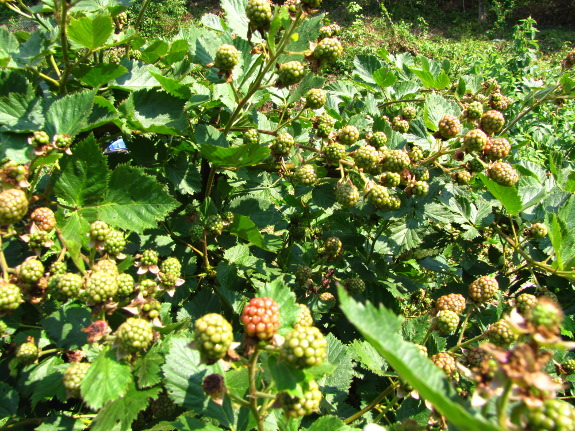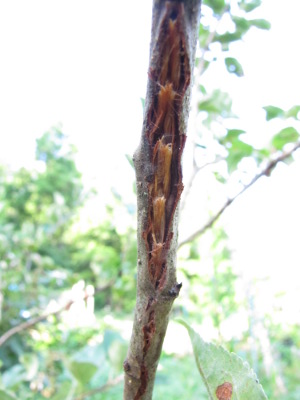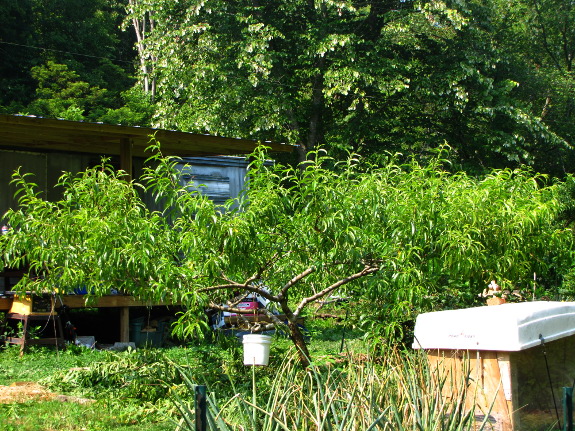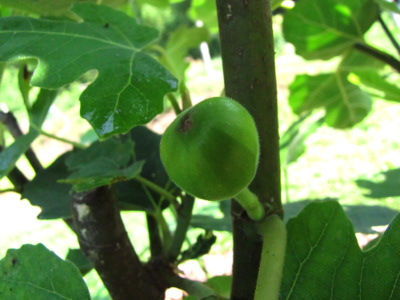
Summer perennial maintenance

As
you can see, we're
working on getting our perennials back in good order this month.
The brambles quickly expand out of their allotted rows if we're not
careful, but a bit of tip-pruning and tying up sets them
straight. I'm actually in awe of the effects of tip-pruning since
the blackberry canes I snipped last year have turned into compact
shrubs nearly solid with berries --- I'll try to remember to take
another photo in a couple of weeks when the berries are ripe so you can
get a better idea of what the plants look like.
Working with our trees
in the summer still gives me fits, though. The Pruning
Book didn't present
much information about summer pruning, and I haven't found many tips on
the topic in The
Holistic Orchard
either. (I've only poked through the index of the latter, though,
not read the book from cover to cover. I can tell it's an
eye-opening book, but haven't had the brain power to settle in for a
solid read this week.)
 One
thing I'm sure of --- I should prune out diseased or insect-ridden wood
whenever I see it. The dead peach twig tips from oriental
fruit moth are easy
to distinguish, but I got stuck on what to do with them after
cutting. I'm hoping that if I drop the twigs to the ground and
cover them up with a healthy dose of wood chip mulch, the larvae inside
will perish due to lack of nutrition. I may regret taking this
lazy way out, though.
One
thing I'm sure of --- I should prune out diseased or insect-ridden wood
whenever I see it. The dead peach twig tips from oriental
fruit moth are easy
to distinguish, but I got stuck on what to do with them after
cutting. I'm hoping that if I drop the twigs to the ground and
cover them up with a healthy dose of wood chip mulch, the larvae inside
will perish due to lack of nutrition. I may regret taking this
lazy way out, though.
Meanwhile, I'm
second-guessing my diagnosis of fireblight. Although the symptoms
looked right on the pears and apples, I saw identical bark lesions on
the peaches and noticed dead twigs and leaves that looked the same on
the blueberries. Since fireblight isn't supposed to hit those
other species, I'm a bit stumped. Could the issue be as simple as
frost damage after all? But if so, why did it spread?

Then there are
watersprouts. I learned from The
Pruning Book that
it's best to yank out the entire watersprout, getting the base so that
it doesn't regrow. I couldn't seem to develop the knack for
ripping the twigs without stripping the bark on the branches left
behind, though, so I simply pruned watersprouts off as close as I
could. I do feel better about this method than about my
previous crazy technique of cutting the watersprouts off a few inches
above the branch ---
that type of heading cut just makes one big watersprout turn into five
small watersprouts.
 Still, my peach trees look
awfully naked with their tops cut off. I'm only about 45% sure
I'm doing the right thing there, so please do your own research before
following suit. A few more years of trial and error may be
necessary to figure out the best methods of summer pruning peaches.
Still, my peach trees look
awfully naked with their tops cut off. I'm only about 45% sure
I'm doing the right thing there, so please do your own research before
following suit. A few more years of trial and error may be
necessary to figure out the best methods of summer pruning peaches.
(P.S. Look!
It's the year of the first homegrown figs on our farm! Assuming
nothing happens to the cute little fruits before they ripen, that is.)
Want more in-depth information? Browse through our books.
Or explore more posts by date or by subject.
About us: Anna Hess and Mark Hamilton spent over a decade living self-sufficiently in the mountains of Virginia before moving north to start over from scratch in the foothills of Ohio. They've experimented with permaculture, no-till gardening, trailersteading, home-based microbusinesses and much more, writing about their adventures in both blogs and books.
Want to be notified when new comments are posted on this page? Click on the RSS button after you add a comment to subscribe to the comment feed, or simply check the box beside "email replies to me" while writing your comment.

Hi - we had believed our peach tree had fireblight and lost an entire season's peaches. We almost cut her down, but decided to spray her with organic antifungal and treat the trunk lesions with white vinegar. We were very happy to have beautiful peaches last year - right up to a day or two before harvest - then saw the peaches turn to brown sunken spotted hardballs overnight - the cause? Stink Bugs!! The local extension looked at the tree and told us the stink bugs could have caused the trunk lesions as well.
Good luck with your figs! This is our third year and nothing can compare to fresh figs from your own trees Are you allowing them to tree and wrapping in winter, or cutting back to bush each year? We were wrapping, but had to move the figs and decided to cut them back and mulch heavily for winter when we did. We have two beautiful fig bushes, but no figs just yet.
Are you allowing them to tree and wrapping in winter, or cutting back to bush each year? We were wrapping, but had to move the figs and decided to cut them back and mulch heavily for winter when we did. We have two beautiful fig bushes, but no figs just yet.
Do you tip prune once they reach the trellis wire height or do you prune again after that? This is the first year I tip-pruned at the higher trellis wire height, but the laterals are now 6-7feet long and arching to the ground as well.
I'm starting to come to the realization that I didn't space my plants far enough apart either.
DharmaDogs --- It sounds like there may be a lookalike disease for peaches? To the best of my researching ability, fireblight doesn't hit them.
I'm so sorry you had trouble with your tree! Peaches do seem to be very hard to grow organically....
We let the figs grow as tall as they get (really only a shrub so far) and then wrap leaves around them for the winter. That only protects as far as the leaves go up, though, so anything over about three or four feet gets nipped back.
Marco --- That sounds a bit like what we're doing, but more laborious. I figure it's okay if the fig stay a bush, so I don't bother bending it down.
Mitsy --- I always find it a lot more effort to burn things than you would think. We don't have an outside fire pit, so I'd have to make one, and then dry the twigs (making sure the insects didn't make their way out in the meantime). Plus, I'd have to do what I did last year, which was a pain --- prune into two locations, with the healthy wood dropping to the ground under the tree and the unhealthy wood going in a container. (That year, I just filled the bucket with water to drown the larvae, and presumably it worked. I did forget about the water until it turned to goop, though....)
Brian --- I wait to pinch off the tips until they're trellis height. If I remember, I plan to pinch back the side shoots of the black raspberries once they get a foot or so long to promote further branching, but I'm okay with just pruning those side branches in the winter if I forget. (That's what I did last year, and it worked well.)
Rebecca --- You're the grand prize winner!!! I never would have thought of that, but you're totally right --- cicadas do lay their eggs in twigs and the damage looks identical to what I'm seeing. I wonder if I don't have fireblight at all, and the cicada damage just killed the leaves on those twigs?
I have always had a lot of problems with sun damage on my fruit trees. Peaches, and my apples get hit the worst, but blueberries and the figs get burnt leafs too. I dont know if you have problems with the sun, but its something to look at.